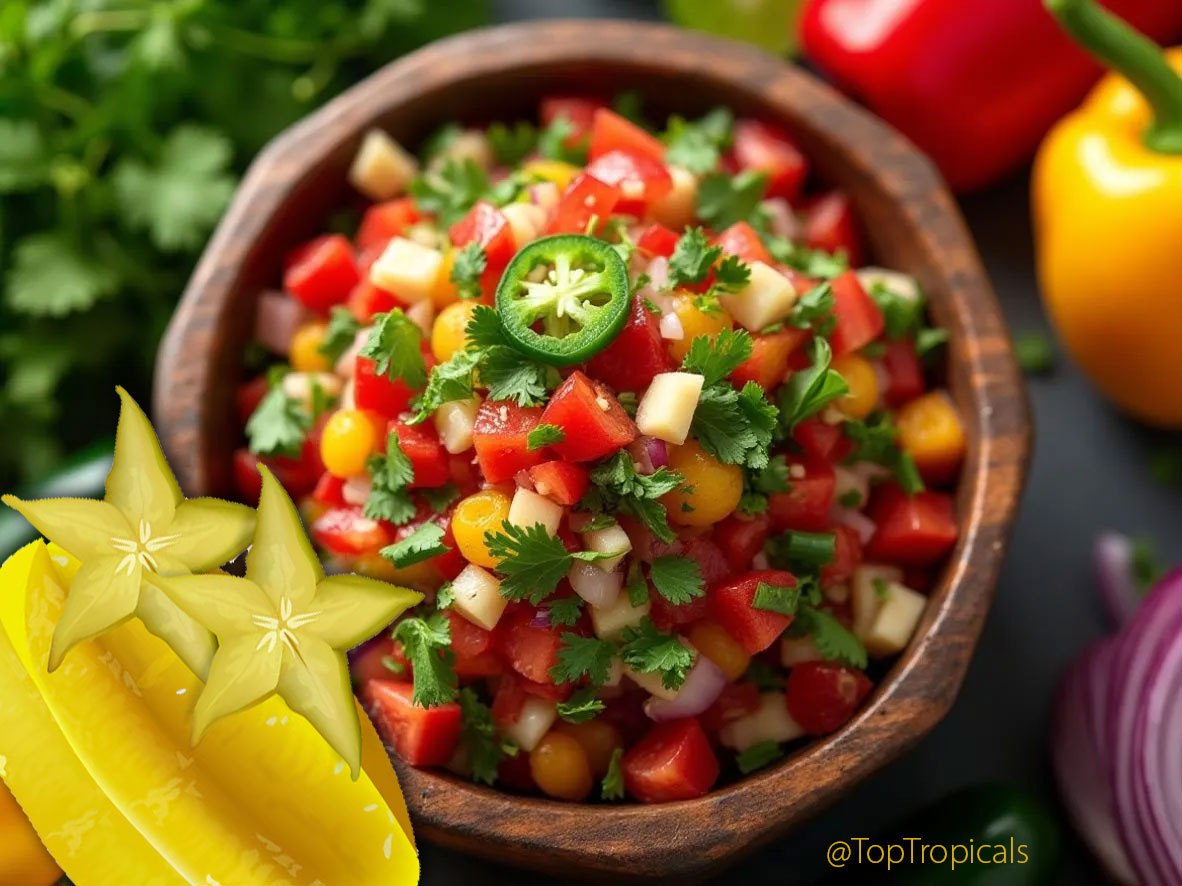Garden Blog - Top Tropicals
How to grow a Guava Tree: Practical Guide to Growing Guava
Guava (Psidium sp.)
🍉 How to grow a Guava Tree: Practical Guide to Growing Guava
· Frequency: Prune guavas annually, ideally after the fruiting season, to encourage new growth and improve airflow.
· Guava trees require consistent watering, especially during dry periods and the fruiting season. While they can tolerate short periods of flooding, ensure the soil is not waterlogged. Water deeply once or twice a week, depending on your climate.
· Guava trees are quick to fruit, often producing their first harvest within a year of planting. For container-grown trees, fruiting can start in even smaller pots, such as 1-gallon containers.
· Guava is a nutrient powerhouse, offering numerous health benefits:
· Tropical Guava (Psidium guajava): Sweet and aromatic, suitable for warmer climates.
🍑 Additional Tips
📚 More from previous posts about #Guava
🛒 Shop Guava Trees
#Food_Forest #Guava
🔴 Join 👉 TopTropicals
- 🍑 Guava Trees (Psidium sp.) are beloved for their flavorful fruit and easy-growing nature. These fast-growing trees are reliable producers and can thrive in a variety of climates, making them a favorite among home gardeners. Guavas are compact and can be grown in containers, making them suitable for small spaces and urban gardens.
- 🍑 Light and Soil
- 🍑 Pruning tips
Guava trees thrive in full sun, requiring at least 6-8 hours of direct sunlight daily to produce the best fruit. They prefer well-draining soils rich in organic matter but are adaptable to a range of soil types, including sandy or loamy soils. Slightly acidic to neutral soil is ideal. While guavas tolerate poor soils, enriching the soil with compost or manure will improve growth and yield.
Pruning is essential for maintaining the shape, size, and productivity of guava trees.
· Frequency: Prune guavas annually, ideally after the fruiting season, to encourage new growth and improve airflow.
- · Remove dead, diseased, or crossing branches to maintain tree health.
- · Shape the tree to allow sunlight to penetrate the canopy, which enhances fruit production.
- · For container-grown guavas, keep the tree compact by trimming back vigorous shoots regularly.
- 🍑 Guava in containers
- 🍑 Watering
Guavas are well-suited to container growing. Compact varieties like the "Nana" guava are ideal for pots. Use a large container (at least 15-20 gallons) with good drainage. Fill it with a high-quality potting mix enriched with organic matter. Place the container in a sunny location and water consistently. Regular pruning helps maintain a manageable size and promotes fruiting in container-grown guavas.
· Guava trees require consistent watering, especially during dry periods and the fruiting season. While they can tolerate short periods of flooding, ensure the soil is not waterlogged. Water deeply once or twice a week, depending on your climate.
- · Fertilize guavas 3-4 times a year during the growing season with a balanced fertilizer rich in potassium and phosphorus to promote flowering and fruiting. Adding organic matter like compost or manure annually boosts soil fertility and improves yields.
- 🍑 Harvesting
· Guava trees are quick to fruit, often producing their first harvest within a year of planting. For container-grown trees, fruiting can start in even smaller pots, such as 1-gallon containers.
- · Signs of ripe guava fruit include:
- · Harvest ripe guavas by hand or with pruning shears. Consume fresh or use them to make juices, jams, or desserts.
- A change in color from green to yellow (depending on the variety).
- A sweet, fruity aroma.
- Slight softness when gently pressed.
- 🍑 Health Benefits of Guava
· Guava is a nutrient powerhouse, offering numerous health benefits:
- · Vitamin C: Boosts the immune system and helps protect against colds and infections.
- · Potassium: Supports healthy blood pressure levels.
- · Antioxidants: Contribute to glowing skin and may reduce the risk of cancer.
- · Fiber: Aids digestion and helps regulate blood sugar levels.
- 🍑 Popular Varieties of Guava
· Tropical Guava (Psidium guajava): Sweet and aromatic, suitable for warmer climates.
- · Cattley Guava (Psidium littorale): Cold-hardy with a slightly tart flavor.
- · Cas Guava (Psidium friedrichsthalianum): Known for its sour taste, perfect for juices like Costa Rica’s traditional "Agua de Cas." Cold hardy, disease resistant and vigorous, productive variety.
- · Pineapple Guava (Feijoa sellowiana): Fruity and floral, thriving in cooler climates.
🍑 Additional Tips
- · Guava trees are relatively pest-resistant but may require monitoring in humid climates for mealybugs. Use neem oil if needed.
- · Planting multiple guava varieties ensures a continuous supply of fruit.
- · With their fast growth, compact size, and delicious fruit, guava trees are a fantastic addition to tropical garden, greenhouse or patio.
📚 More from previous posts about #Guava
🛒 Shop Guava Trees
#Food_Forest #Guava
🔴 Join 👉 TopTropicals
Eyes with a Tail
😎 Eyes with a Tail...
📸 Georgie's tail (a proof for yesterday's post)
🔠 PeopleCats.Garden
#PeopleCats
🔴 Join 👉 TopTropicals
📸 Georgie's tail (a proof for yesterday's post)
🔠 PeopleCats.Garden
#PeopleCats
🔴 Join 👉 TopTropicals
Calliandra Tree everyone should have: how big and fast does it grow?
🎈 Calliandra Tree everyone should have: how big and fast does it grow?
✅ Calliandra houstoniana - Tree Calliandra - is the only tree form of Powderpuff. It quickly grows into a bushy beautiful tree under 20 ft - in just one season, and fluffy pink flowers attract hummingbirds and butterflies year around
📚 More prom previous post:
What Tree Calliandra brings into your garden
🛒 Order
#Trees #Hedges_with_benefits #Butterfly_Plants #Trees
🏵 TopTropicals
✅ Calliandra houstoniana - Tree Calliandra - is the only tree form of Powderpuff. It quickly grows into a bushy beautiful tree under 20 ft - in just one season, and fluffy pink flowers attract hummingbirds and butterflies year around
📚 More prom previous post:
What Tree Calliandra brings into your garden
🛒 Order
#Trees #Hedges_with_benefits #Butterfly_Plants #Trees
🏵 TopTropicals
The Tailless and the Bushy Tail
👍 The Tailless and the Bushy Tail...
📸 Matilda is a tailless Manx breed, and Georgie has a tail size of a peacock's!
Put a ♥️ for "not fair", and a 👍 for a "tough life"
🔠 PeopleCats.Garden
#PeopleCats
🔴 Join 👉 TopTropicals
📸 Matilda is a tailless Manx breed, and Georgie has a tail size of a peacock's!
Put a ♥️ for "not fair", and a 👍 for a "tough life"
🔠 PeopleCats.Garden
#PeopleCats
🔴 Join 👉 TopTropicals
When you have a big crop of Star Fruit: sweet and Spicy Carambola Salsa recipe
⭐️ When you have a big crop of Star Fruit: sweet and Spicy Carambola Salsa recipe
😁 Ingredients:
📞 Instructions:
🎁 This recipe balances carambola's sweet-tart flavor with a spicy kick! 😏
🛒 Plant your own Carambola Tree
#Food_Forest #Recipes
🔴 Join 👉 TopTropicals
😁 Ingredients:
- · 2 ripe Carambola (starfruit), finely diced
- · 1 small red bell pepper, diced
- · 1 small red onion, finely chopped
- · 1 jalapeño, seeded and minced
- · 2 tablespoons fresh cilantro, chopped
- · Juice of 1 lime
- · 1 tablespoon honey or agave syrup
- · Pinch of salt
📞 Instructions:
- · Combine the diced carambola, red bell pepper, red onion, jalapeño, and cilantro in a bowl.
- · Add lime juice, honey, and a pinch of salt. Mix well.
- · Chill in the fridge for 15–30 minutes to let the flavors meld.
- · Serve with tortilla chips, grilled fish, or as a topping for tacos.
🎁 This recipe balances carambola's sweet-tart flavor with a spicy kick! 😏
🛒 Plant your own Carambola Tree
#Food_Forest #Recipes
🔴 Join 👉 TopTropicals
Dishes again??? I did them yesterday
🔪 Dishes again??? I did them yesterday...
📸 Bob is always involved in house chores
🔠 PeopleCats.Garden
#PeopleCats
🔴 Join 👉 TopTropicals
📸 Bob is always involved in house chores
🔠 PeopleCats.Garden
#PeopleCats
🔴 Join 👉 TopTropicals
Mango Rainbow tasting table: varieties you should try
Kent Mango
🌈 Mango Rainbow tasting table: varieties you should try
❔ What Mango varieties do you have in your garden?
Share in comments 👇
📚 Previous Mango Rainbow Tasting Table: 1 • 2 • 3 •
🛒 Shop Mango varieties
#Food_Forest #Mango #Mango_Rainbow
🔴 Join 👉 TopTropicals
- Kent Mango variety is native to Florida. It is originated in Coconut Grove, in 1945 from a Haden seed.
- Kent has an excellent flavor, large size, and very little fiber. Considered by many to be one of the best tasting Florida mangoes and one of the most beautiful, truly rainbow colored fruit!
- Eat before fruit gets too ripe.
- The most rewarding attribute is a bountiful late season crop.
❔ What Mango varieties do you have in your garden?
Share in comments 👇
📚 Previous Mango Rainbow Tasting Table: 1 • 2 • 3 •
🛒 Shop Mango varieties
#Food_Forest #Mango #Mango_Rainbow
🔴 Join 👉 TopTropicals
How to grow Mandevilla: Practical Guide to Growing Mandevilla Vine
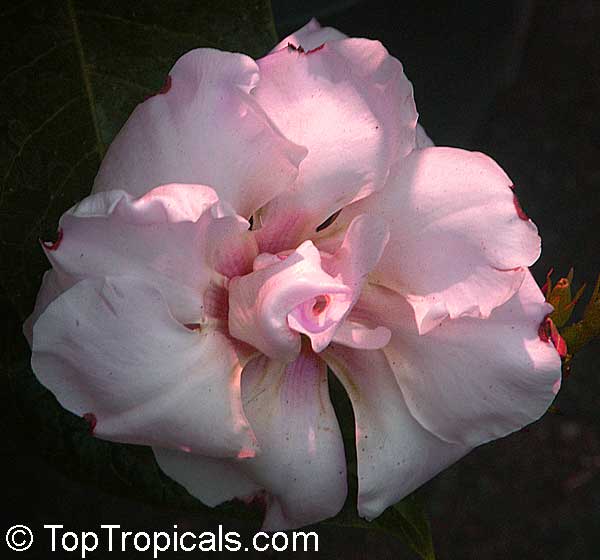
Mandevilla amabilis Thai Rose
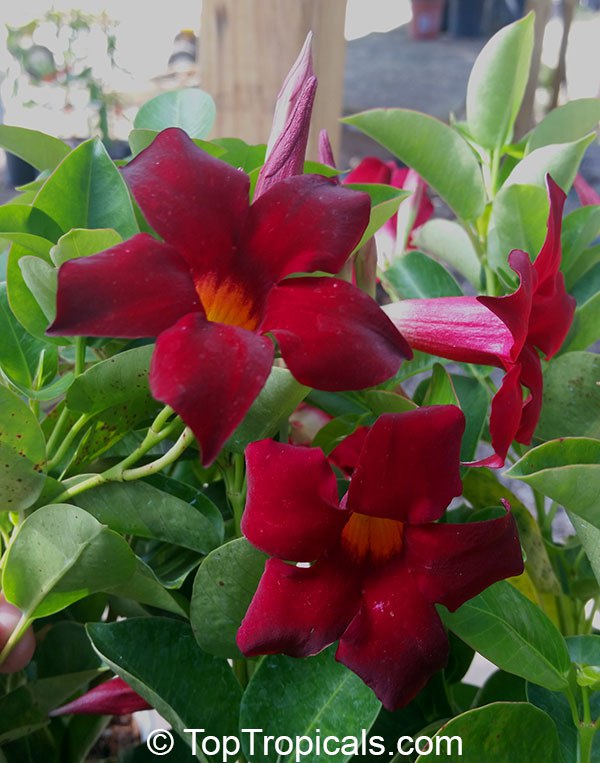
Mandevilla Sun Parasol Crimson
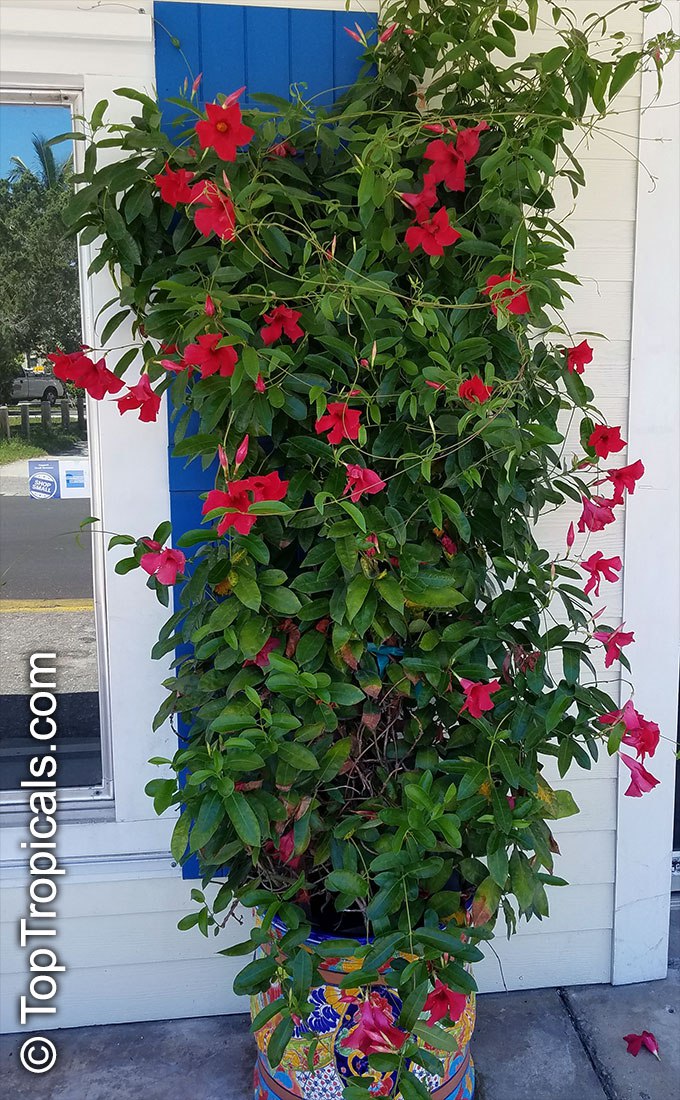
Mandevilla Sun Parasol Crimson on a trellis
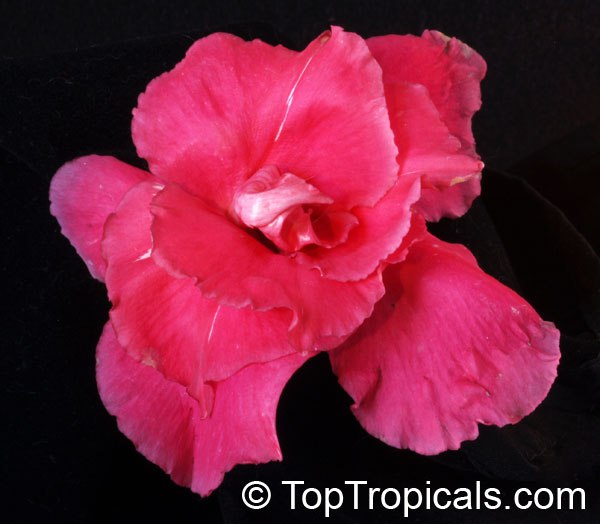
Mandevilla amabilis Thai Rose
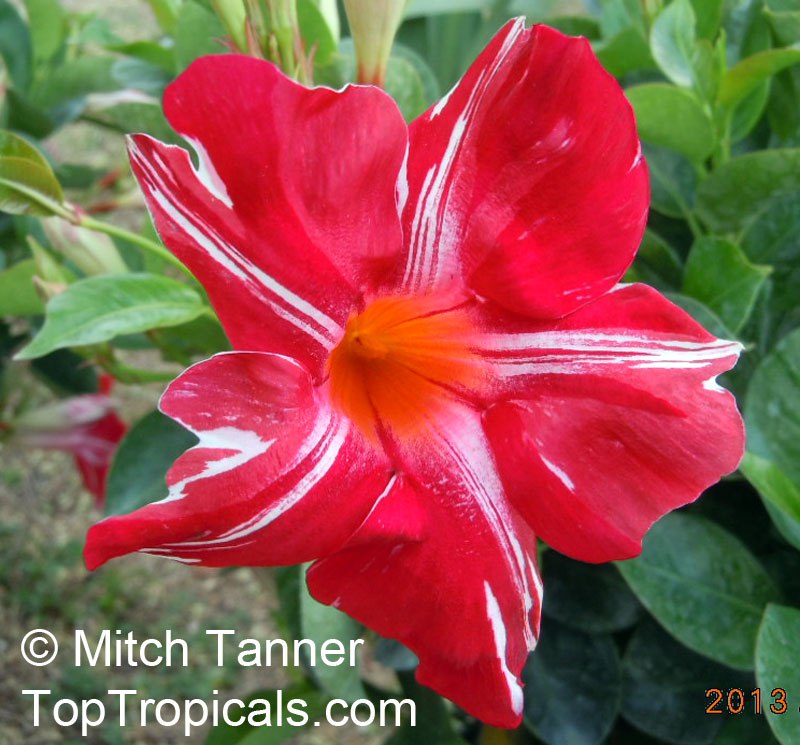
Mandevilla Stars and Stripes
🌺 How to grow Mandevilla: Practical Guide to Growing Mandevilla Vine
💋Soil. Mandevilla prefers well-draining soil enriched with organic matter. A mix of garden soil, compost, and sand ensures good drainage and fertility. Both Mandevilla and Dipladenia require acidic soil. If your native soil contains limestone, consider growing them in containers with a peat-based potting mix to maintain a lower pH.
💋Mandevilla ‘Alice du Pont’– A classic pink variety with large flowers and vigorous growth.
💋Spray with a neem oil solution weekly if pests are present.
🌺 Growing Mandevilla in Pots and Winter Care
Mandevilla grows beautifully in containers, making it a great option for cooler climates where it can be brought indoors for winter.
· Use a well-draining potting mix with added perlite for aeration.
💋Winter Care:
With the right care, Mandevilla provides stunning, long-lasting blooms and thrives in gardens or pots, making it a versatile and rewarding addition to any space.
📚 Learn more from previous post:
How to overwinter Mandevilla indoors
🛒 Shop flowering vines
#How_to #Container_Garden #Hedges_with_benefits
🔴 Join 👉 TopTropicals
- 🌺 Mandevilla is a tropical vine known for its vibrant, trumpet-shaped flowers that bloom throughout the warm months. This fast-growing climber thrives in warm climates and adds a stunning display of color to gardens and patios.
- 🌺 Difference Between Mandevilla and Dipladenia
- 🌺 Growing in the Ground
The names Mandevilla and Dipladenia are often used interchangeably, creating confusion. While they are closely related, there are key differences. Mandevilla is a vigorous woody vine with large, stiff leaves, ideal for trellises and fences. Dipladenia, on the other hand, has a more compact growth habit with smaller, smooth leaves. Dipladenia can be also trained on a trellis but also thrives in hanging baskets or as a compact specimen plant. As a bushier type of Mandevilla, its smaller, more compact varieties are excellent for mixed containers.
💋Soil. Mandevilla prefers well-draining soil enriched with organic matter. A mix of garden soil, compost, and sand ensures good drainage and fertility. Both Mandevilla and Dipladenia require acidic soil. If your native soil contains limestone, consider growing them in containers with a peat-based potting mix to maintain a lower pH.
- 💋Light. Plant in a location with full sun to partial shade; at least 6 hours of direct sunlight promotes the best blooms.
- 💋Feeding and Encouraging More Blooms: Feed Mandevilla with Sunshine Boosters Megaflor with every watering to encourage more blooms. Prune lightly after flowering to promote new growth and continuous flowering.
Water Mandevilla regularly, keeping the soil moist but not soggy. During hot months, water deeply a few times a week. Reduce watering in cooler seasons.
- 🌺 Most Interesting Varieties
Mandevilla flowers come in a wide range of colors, including shades of red, mauve, pink, white, and even yellow. For vibrant color and impact, consider these varieties:
💋Mandevilla ‘Alice du Pont’– A classic pink variety with large flowers and vigorous growth.
- 💋Mandevilla ‘Sun Parasol’ Series – Offers compact plants in deep red, pink, or white, great for containers or small spaces.
- 💋Mandevilla ‘Crimson Red’– Deep red blooms stand out against glossy green foliage.
- 💋Dipladenia ‘Stars and Stripes’ - features striking red-and-white striped blooms.
In Florida, Sun Parasol and Alice du Pont perform exceptionally well, thriving in the heat and humidity while providing season-long blooms.
- 🌺 Pests and Problems
Mandevilla is relatively pest-resistant but can attract aphids, spider mites, and whiteflies. To manage pests:
💋Spray with a neem oil solution weekly if pests are present.
- 💋Encourage beneficial insects like ladybugs to control aphids naturally.
- 💋Remove affected leaves and rinse plants with a strong stream of water.
- 💋Watch for fungal diseases in humid climates; ensure good air circulation and avoid overhead watering.
🌺 Growing Mandevilla in Pots and Winter Care
Mandevilla grows beautifully in containers, making it a great option for cooler climates where it can be brought indoors for winter.
- 💋Pot Growing Tips:
· Use a well-draining potting mix with added perlite for aeration.
- · Choose a pot at least 12-16 inches in diameter, with several drainage holes, for vigorous growth.
- · Water when the top inch of soil feels dry, avoiding waterlogged conditions.
💋Winter Care:
- · In regions with frost, move potted Mandevilla indoors to a bright, cool location (50-60°F).
- · Reduce watering and stop fertilizing during cooler season.
- · Prune lightly before bringing indoors to maintain shape and size.
- · Repotting: Repot every 2-3 years in early spring before active growth begins, refreshing the soil and upgrading to a slightly larger container if needed.
With the right care, Mandevilla provides stunning, long-lasting blooms and thrives in gardens or pots, making it a versatile and rewarding addition to any space.
📚 Learn more from previous post:
How to overwinter Mandevilla indoors
🛒 Shop flowering vines
#How_to #Container_Garden #Hedges_with_benefits
🔴 Join 👉 TopTropicals
Productive Relaxation
😪 Productive Relaxation
"Sometimes the most productive thing you can do is relax." - Mark Black
🔠 PeopleCats.Garden
#PeopleCats #Quotes
🔴 Join 👉 TopTropicals
"Sometimes the most productive thing you can do is relax." - Mark Black
🔠 PeopleCats.Garden
#PeopleCats #Quotes
🔴 Join 👉 TopTropicals
Can you grow plums in Florida?
Plum tree fruiting in Florida
💝 Can you grow plums in Florida?
💕 Yes, absolutely! This year, starting end of January, we are harvesting our first Plums... Sweet!
🎥 Scarlet Beauty Plum. Hypoluxo variety just started flowering, fruit coming soon!
📚 Learn more from previous post:
The most rewarding hardy fruit tree suitable for hot climate: peaches, nectarines, apricots and plums
🛒 Shop Low Chill Peaches, Nectsrunes, and Plums
#Food_Forest
🔴 Join 👉 TopTropicals
💕 Yes, absolutely! This year, starting end of January, we are harvesting our first Plums... Sweet!
🎥 Scarlet Beauty Plum. Hypoluxo variety just started flowering, fruit coming soon!
📚 Learn more from previous post:
The most rewarding hardy fruit tree suitable for hot climate: peaches, nectarines, apricots and plums
🛒 Shop Low Chill Peaches, Nectsrunes, and Plums
#Food_Forest
🔴 Join 👉 TopTropicals
